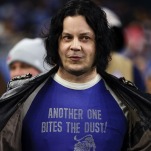My Year Of Flops Case File # 44 Cool World (1992)
In the late '80s and early '90s, animation was undergoing one of its periodic booms. After bottoming out with Black Cauldron, Disney roared back to life spectacularly with Little Mermaid and a raft of critically revered blockbusters. The 1988 smash hit Who Framed Roger Rabbit? seemed to herald an exhilarating new age where animation and live action comfortably co-existed with unparalleled sophistication and wit.
Ex-Disney animator Don Bluth, meanwhile, had transformed his homegrown studio into a legitimate threat to his old employers with hits like An American Tail and The Land Before Time, a series that's currently approaching its 700th direct-to-DVD sequel. On television, America had fallen in love with a gang of mustard-yellow, four-fingered misfits called The Simpsons and, to a much lesser extent, various Capitol Critters and Crime-Solving Fish.
In other words, the time was perfect for Ralph Bakshi–the bad boy of animation, the prince of perversion, the king of kink, the Disney of debauchery, the poet laureate of animated porn, and the Tex Avery of the trench coat set–to make a spectacular comeback after abandoning film following decades of disappointment, false starts, and studio idiocy. He'd even dreamed up the perfect vehicle for his return: a sexy, violent, R-rated horror cartoon combining live action and animation. In a fit of ambition, he sold his idea for a horror cartoon about a hip underground cartoonist stalked by the half-animated offspring of an ill-fated tryst with a cartoon sexpot to Paramount.
Bakshi was back! One of cinema's great bitter, jilted cranks was suddenly overcome with a tricky emotion I believe you earthlings call "hope." But if Bakshi's long and tortured career had taught him anything, it's that dreams exist to be crushed and hope is for suckers. Accordingly, the film's producer Frank Mancusco Jr., had the film rewritten without, um, telling Bakshi. Mancusco Jr., it seems, having produced the timeless gift to cinema that is the Friday The 13th series, was burnt out on horror and seemed to linger under the misconception that it was Bakshi's job to help realize Frank Mancusco's vision, not the other way around.
Bakshi was so enraged, he punched Mancuso in the face during a dust-up, but in one of those dark little twists that characterize Bakshi's surreal career, Mancuso Sr. was president of Paramount, so he had nowhere else to go. Beyond having his script taken away from him, Bakshi was thwarted on other fronts as well. He desperately wanted to cast a sexy young actor named Brad Pitt for the lead role of a hip underground cartoonist tempted by his own two-dimensional creation. The studio was having none of it. "Get us Byrne, dammit! Only Gabriel Byrne can play this role! Byrne is boffo! Byrne means box-office! Byrne will take us to the Promised Land! Byrne! Byrne! Byrne! Screw that no-charisma Pitt kid! He's on a bullet train straight to Nowheresville! Byrne is where it's at!" I imagine a red-faced, fat-fingered studio executive barking angrily into a phone between puffs of a Cuban cigar.
Middle-aged journeyman character actor Gabriel Byrne was consequently cast in the male lead while Pitt was relegated to the still-substantial part of a '40s gumshoe sucked into an animated universe and burdened with keeping humans and cartoons from having sex and, um, messing with the fabric of the universe. For the female lead, Bakshi wanted sexy young thing Drew Barrymore as his cartoon vixen, but was saddled with Kim Basinger, whom Bakshi derisively claimed would be the perfect choice to play a "49-year-old woman," but was far too old and gross for his film.
In a story that's far too ridiculous not to be true, Bakshi claims that halfway through the film, Basinger told Bakshi that she'd really like to be able to show the film to sick children in hospitals. In keeping with the warped way of American studio filmmaking, Bakshi's revolutionary, sexy, violent R-rated animated horror film had morphed into a movie Kim Basinger wanted to show cancer-stricken tots.







![Rob Reiner's son booked for murder amid homicide investigation [Updated]](https://img.pastemagazine.com/wp-content/avuploads/2025/12/15131025/MixCollage-15-Dec-2025-01-10-PM-9121.jpg)

























![HBO teases new Euphoria, Larry David, and much more in 2026 sizzle reel [Updated]](https://img.pastemagazine.com/wp-content/avuploads/2025/12/12100344/MixCollage-12-Dec-2025-09-56-AM-9137.jpg)






